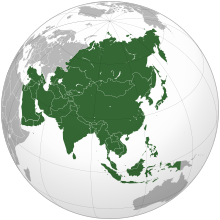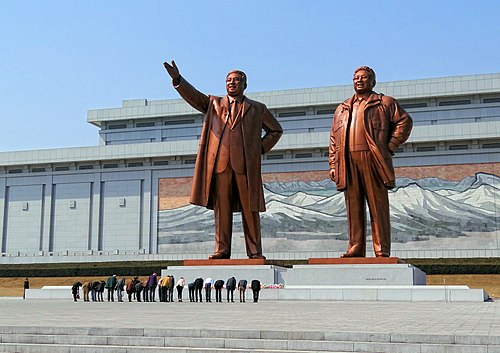Portal:Asia

 Asia (/ˈeɪʒə/ AY-zhə, UK also /ˈeɪʃə/ AY-shə) is the largest continent in the world by both land area and population. It covers an area of more than 44 million square kilometers, about 30% of Earth's total land area and 8% of Earth's total surface area. The continent, which has long been home to the majority of the human population, was the site of many of the first civilizations. Its 4.7 billion people constitute roughly 60% of the world's population. Asia shares the landmass of Eurasia with Europe, and of Afro-Eurasia with both Europe and Africa. In general terms, it is bounded on the east by the Pacific Ocean, on the south by the Indian Ocean, and on the north by the Arctic Ocean. The border of Asia with Europe is a historical and cultural construct, as there is no clear physical and geographical separation between them. It is somewhat arbitrary and has moved since its first conception in classical antiquity. The division of Eurasia into two continents reflects East–West cultural, linguistic, and ethnic differences, some of which vary on a spectrum rather than with a sharp dividing line. A commonly accepted division places Asia to the east of the Suez Canal separating it from Africa; and to the east of the Turkish Straits, the Ural Mountains and Ural River, and to the south of the Caucasus Mountains and the Caspian and Black seas, separating it from Europe. China and India traded places as the largest economies in the world from 1 to 1800 CE. China was a major economic power for much of recorded history, with the highest GDP per capita until 1500. The Silk Road became the main east–west trading route in the Asian hinterlands while the Straits of Malacca stood as a major sea route. Asia has exhibited economic dynamism as well as robust population growth during the 20th century, but overall population growth has since fallen. Asia was the birthplace of most of the world's mainstream religions including Hinduism, Zoroastrianism, Judaism, Jainism, Buddhism, Confucianism, Taoism, Christianity, Islam, Sikhism, as well as many other religions. (Full article...) Featured article The Manila Light Rail Transit System, commonly known as the LRT, is an urban rail transit system that primarily serves Metro Manila, Philippines. Although categorized as a light rail system because it originally used light rail vehicles, it presently has characteristics of a rapid transit system, such as high passenger throughput, exclusive right-of-way, and later use of full metro rolling stock. The LRT is jointly-operated by the Light Rail Transit Authority (LRTA), a government corporation attached to the Department of Transportation (DOTr), and the Light Rail Manila Corporation (LRMC). Along with the Manila Metro Rail Transit System and the Metro Commuter Line of the Philippine National Railways, the system makes up Metro Manila's rail infrastructure. The LRT's 37.24-kilometer-route (23.14 mi) is mostly elevated and consists of two lines and 33 stations. Line 1, also called the Green Line (formerly known as the Yellow Line), opened in 1984 and travels a north–south route. Line 2, the Blue Line (formerly, the Purple Line), was completed in 2004 and runs east–west. The original Line 1 was built as a no-frills means of public transport and lacks some features and comforts, but the newer Line 2 has been built with additional standards and criteria in mind like barrier-free access. In 2022, the system served 305,264 passengers on average. Security guards at each station conduct inspections and provide assistance. A reusable plastic magnetic ticketing system has replaced the previous token-based system in 2001, and the Flash Pass was introduced as a step towards a more integrated transportation system. In 2015, the plastic magnetic tickets were replaced with the Beep, a contactless smart card, introduced to provide a common ticketing to 3 rail lines and some bus lines. (Full article...)Selected Country The United Arab Emirates (UAE), or simply the Emirates, is a country in West Asia, in the Middle East. Located at the eastern end of the Arabian Peninsula, it shares borders with Oman and Saudi Arabia; as well as maritime borders in the Persian Gulf with Qatar and Iran. The United Arab Emirates is an elective monarchy formed from a federation of seven emirates. , the UAE has an estimated population of 9.97 million. Emirati citizens are estimated to form 11.6% of the population; the remaining residents are expatriates, the majority of whom are South Asian. Islam is the official religion and Arabic is the official language. Abu Dhabi is the country's capital, while Dubai, the most populous city, is an international hub. The United Arab Emirates' oil and natural gas reserves are the world's sixth and seventh-largest, respectively. Zayed bin Sultan Al Nahyan, ruler of Abu Dhabi and the country's first president, oversaw the development of the Emirates by investing oil revenues into healthcare, education, and infrastructure. The country has the most diversified economy among the members of the Gulf Cooperation Council. In the 21st century, the UAE has become less reliant on oil and gas and is economically focusing on tourism and business. The UAE is considered a middle power. It is a member of the United Nations, Arab League, Organisation of Islamic Cooperation, OPEC, Non-Aligned Movement, World Trade Organization, Gulf Cooperation Council (GCC) and BRICS. The UAE is also a dialogue partner of the Shanghai Cooperation Organisation. (Full article...)Featured biographyAyumi Hamasaki (浜崎あゆみ, Hamasaki Ayumi, born October 2, 1978) is a Japanese singer, songwriter, record producer, actress, model, spokesperson, and entrepreneur. By 2002, Hamasaki had earned the nickname "Empress of J-pop" due to her popularity in Japan and throughout Asia, as well as being referred to as "the voice of the lost generation". Due to her success and relevance throughout her career, she is considered one of the top solo female artists of the Heisei era for her influence on the music industry and various fashion trends. Born and raised in Fukuoka, Fukuoka Prefecture, Hamasaki moved to Tokyo at 14 in 1993 to pursue a career in singing and acting. In 1998, Hamasaki released her debut single "Poker Face" and debut major-label album A Song for ××. The album debuted at the top of the Oricon charts and remained there for five weeks, selling over a million copies. This rapid rise to fame is typically attributed to her insightful style of lyric-writing in contrast to her young age; this would continue to be a defining aspect of her work, listeners praising her poetic way of conveying relatable subjects. Her next ten albums shipped over a million copies in Japan, with her third, Duty, selling nearly three million. A Best, her first compilation album, further established her position as a crowning artist with more than four million copies sold in Japan. It was at this time that she represented more than 40% of her record label's income. (Full article...)General imagesThe following are images from various Asia-related articles on Wikipedia. Featured pictureVisitors bowing in a show of respect for North Korean leaders Kim Il-sung and Kim Jong-il on Mansudae (Mansu Hill) in Pyongyang, North Korea.
Did you know...
Updated: 6:33, 14 February 2024 In the news
Related portalsMajor Religions in Asia Middle East Central Asia and Surroundings Indian Subcontinent Southeast Asia East Asia Selected panorama
Baalbek is a town in the Beqaa Valley of Lebanon situated east of the Litani River. It is famous for its exquisitely detailed yet monumentally scaled temple ruins of the Roman period, when Baalbek, then known as Heliopolis, was one of the largest sanctuaries in the Empire. TopicsCategoriesAssociated WikimediaThe following Wikimedia Foundation sister projects provide more on this subject:
More portalsShortcuts to this page: Asia portal • P:ASIA Purge server cache |






























































































